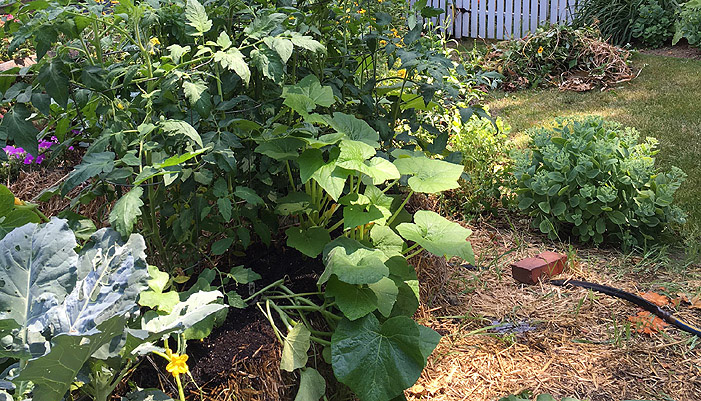
July has been doing her best to make up for a cool Spring. Keeping the plants in my straw bale garden fed and hydrated has been my main focus. Thank heavens for soaker hoses and the occasional rain shower or thunderstorm.
As far as my straw bale gardening experiment is going, the tomatoes, cucumbers, broccoli, and squash are growing so well, they are taking over the “Straw Bale Neighborhood!” Their closet neighbors, green peppers and string beans, are feeling the pressure of limited real estate. The cucumbers are not respecting the space allocated to the string beans, and the broccoli are overshadowing the peppers and hogging the sunshine.
Next year, I plan to give the tomatoes, cucumbers, broccoli, and squash a separate straw bale of their own. They are prolific growers and their vines and leaves need more “leaf” room, even if you provide a trellis or in a tomato cage. Also, I would plant more upright vegetables in between, such as onions, carrots and herbs.
In my last posting, I described making my own seed tape using paper towels and flour paste.
The technique was quick and easy and sounded less expensive. However, the “quicker picker upper” brand of my paper towel may have been a little too challenging for some of the tinier seeds to penetrate. I think a thinner, less absorbent (and probably less expensive) brand, might work just as well. The larger seeds from beans, cucumbers, and pumpkins seemed to do a little better.
Planting from seeds really needs to be started earlier indoors, especially with a later than usual start to the growing season. Even though the straw bales act like little greenhouses, they can only do so much.
And finally, always remember to have a Plan B. Although some of the seeds did propagate, their plants were miniscule, so I reverted back to what I planted last year: organic pepper, tomato, cucumber, and squash seedlings. This will allow me to have fresh vegetables by next month and decide whether I want to experiment with seed tapes and grow lights next winter.
RECIPE
(“Heather’s Cilantro, Black Bean and Corn Salsa” http://allrecipes.com)
Because I have fresh cilantro growing in my garden and local corn is in, I plan to enjoy making Black Bean and Corn Salsa this time of year. I suggest using fresh corn, tomatoes and limes.
Ingredients
1-15 ounce can each of yellow and white corn, drained
2-15 ounce cans of black beans, drained and rinsed
1-14 ounce can Italian tomatoes, drained
1 bunch, finely chopped cilantro
5 green onions, finely sliced
1 small red onion, finely chopped
1 tbsp minced garlic
1/4 cup lime juice
2 Tbsp olive oil, or to taste
(optional) 1 avocado peeled and diced
Directions
- Stir veggies together.
- Add limejuice and drizzle with olive oil to taste.
- Enjoy!
